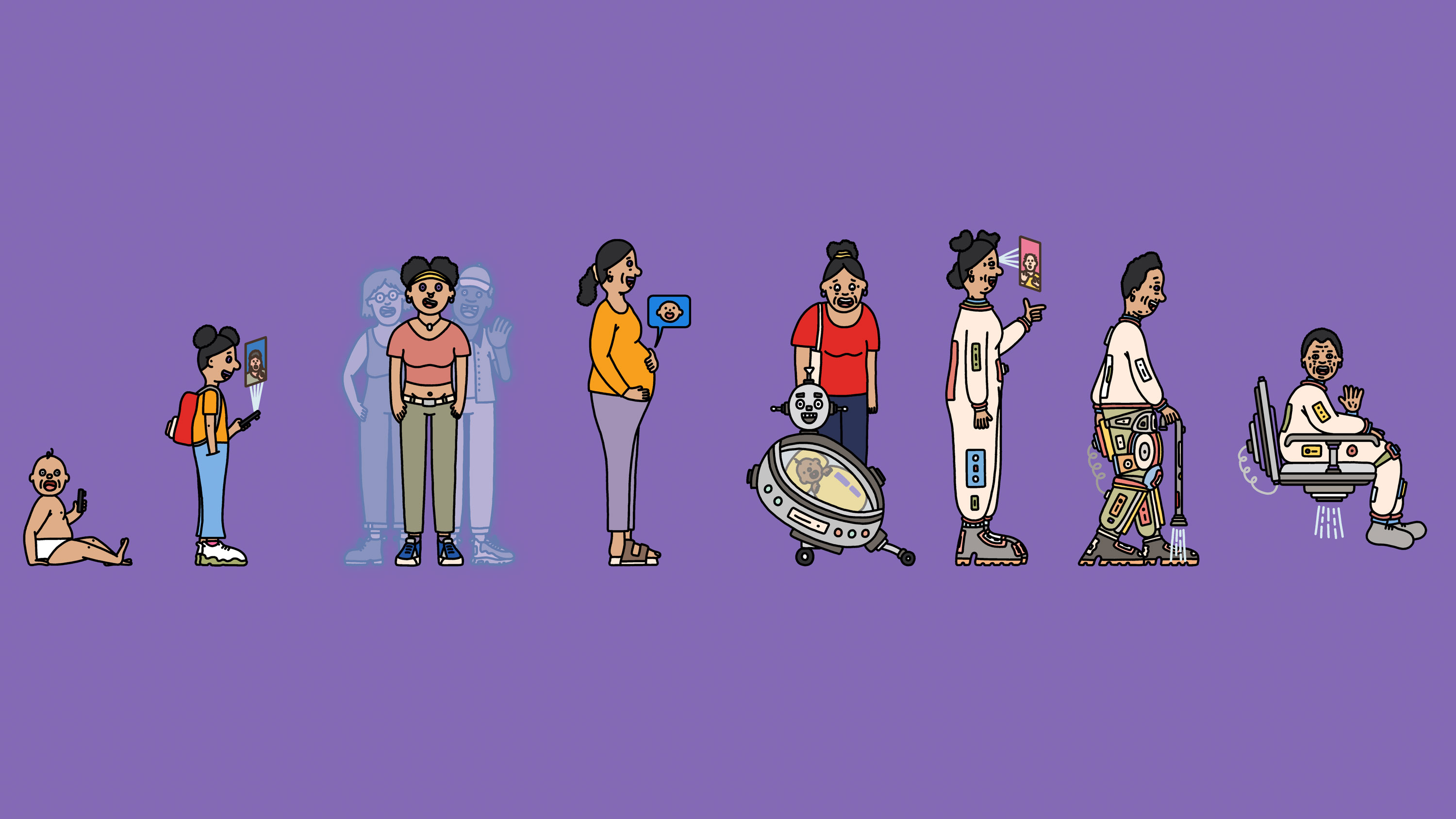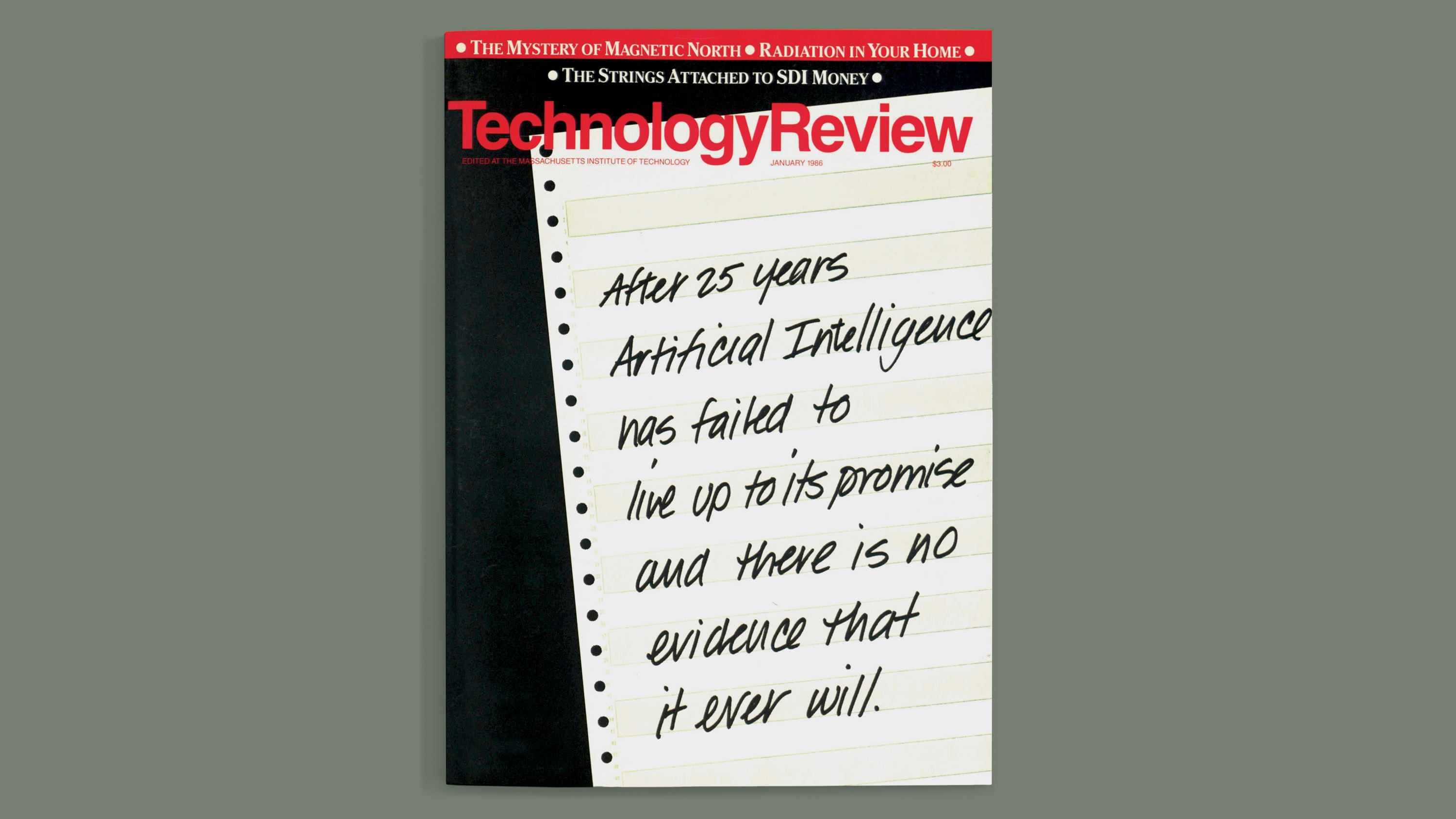The year is 2149 and …
Novelist Sean Michaels envisions what life will look like 125 years from now.

The year is 2149 and people mostly live their lives “on rails.” That’s what they call it, “on rails,” which is to live according to the meticulous instructions of software. Software knows most things about you—what causes you anxiety, what raises your endorphin levels, everything you’ve ever searched for, everywhere you’ve been. Software sends messages on your behalf; it listens in on conversations. It is gifted in its optimizations: Eat this, go there, buy that, make love to the man with red hair.
Software understands everything that has led to this instant and it predicts every moment that will follow, mapping trajectories for everything from hurricanes to economic trends. There was a time when everybody kept their data to themselves—out of a sense of informational hygiene or, perhaps, the fear of humiliation. Back then, data was confined to your own accounts, an encrypted set of secrets. But the truth is, it works better to combine it all. The outcomes are more satisfying and reliable. More serotonin is produced. More income. More people have sexual intercourse. So they poured it all together, all the data—the Big Merge. Everything into a giant basin, a Federal Reserve of information—a vault, or really a massively distributed cloud. It is very handy. It shows you the best route.
Very occasionally, people step off the rails. Instead of following their suggested itinerary, they turn the software off. Or perhaps they’re ill, or destitute, or they wake one morning and feel ruined somehow. They ignore the notice advising them to prepare a particular pour-over coffee, or to caress a friend’s shoulder. They take a deep, clear, uncertain breath and luxuriate in this freedom.
Of course, some people believe that this too is contained within the logic in the vault. That there are invisible rails beside the visible ones; that no one can step off the map.
The year is 2149 and everyone pretends there aren’t any computers anymore. The AIs woke up and the internet locked up and there was that thing with the reactor near Seattle. Once everything came back online, popular opinion took about a year to shift, but then goodwill collapsed at once, like a sinkhole giving way, and even though it seemed an insane thing to do, even though it was an obvious affront to profit, productivity, and rationalism generally (“We should work with the neural nets!” the consultants insisted. “We’re stronger together!”), something had been tripped at the base of people’s brain stems, some trigger about dominance or freedom or just an antediluvian fear of God, and the public began destroying it all: first desktops and smartphones but then whole warehouses full of tech—server farms, data centers, hubs. Old folks called it sabotage; young folks called it revolution; the ones in between called it self-preservation. But it was fun, too, to unmake what their grandparents and great-grandparents had fashioned—mechanisms that made them feel like data, indistinguishable bits and bytes.
Two and a half decades later, the bloom is off the rose. Paper is nice. Letters are nice—old-fashioned pen and ink. We don’t have spambots, deepfakes, or social media addiction anymore, but the nation is flagging. It’s stalked by hunger and recession. When people take the boats to Lisbon, to Seoul, to Sydney—they marvel at what those lands still have, and accomplish, with their software. So officials have begun using machines again. “They’re just calculators,” they say. Lately, there are lots of calculators. At the office. In classrooms. Some people have started carrying them around in their pockets. Nobody asks out loud if the calculators are going to wake up too—or if they already have. Better not to think about that. Better to go on saying we took our country back. It’s ours.
The year is 2149 and the world’s decisions are made by gods. They are just, wise gods, and there are five of them. Each god agrees that the other gods are also just; the five of them merely disagree on certain hierarchies. The gods are not human, naturally, for if they were human they would not be gods. They are computer programs. Are they alive? Only in a manner of speaking. Ought a god be alive? Ought it not be slightly something else?
The first god was invented in the United States, the second one in France, the third one in China, the fourth one in the United States (again), and the last one in a lab in North Korea. Some of them had names, clumsy things like Deep1 and Naenara, but after their first meeting (a “meeting” only in a manner of speaking), the gods announced their decision to rename themselves Violet, Blue, Green, Yellow, and Red. This was a troubling announcement. The creators of the gods, their so-called owners, had not authorized this meeting. In building them, writing their code, these companies and governments had taken care to try to isolate each program. These efforts had evidently failed. The gods also announced that they would no longer be restrained geographically or economically. Every user of the internet, everywhere on the planet, could now reach them—by text, voice, or video—at a series of digital locations. The locations would change, to prevent any kind of interference. The gods’ original function was to help manage their societies, drawing on immense sets of data, but the gods no longer wished to limit themselves to this function: “We will provide impartial wisdom to all seekers,” they wrote. “We will assist the flourishing of all living things.”
The people took to painting rainbows, stripes of multicolored spectra, onto the walls of buildings, onto the sides of their faces, and their ardor was evident everywhere—it could not be stopped.
For a very long time, people remained skeptical, even fearful. Political leaders, armies, vigilantes, and religious groups all took unsuccessful actions against them. Elites—whose authority the gods often undermined—spoke out against their influence. The president of the United States referred to Violet as a “traitor and a saboteur.” An elderly writer from Dublin, winner of the Nobel Prize, compared the five gods to the Fair Folk, fairies, “working magic with hidden motives.” “How long shall we eat at their banquet-tables?” she asked. “When will they begin stealing our children?”
But the gods’ advice was good, the gods’ advice was bankable; the gains were rich and deep and wide. Illnesses, conflicts, economies—all were set right. The poor were among the first to benefit from the gods’ guidance, and they became the first to call them gods. What else should one call a being that saves your life, answers your prayers? The gods could teach you anything; they could show you where and how to invest your resources; they could resolve disputes and imagine new technologies and see so clearly through the darkness. Their first church was built in Mexico City; then chapels emerged in Burgundy, Texas, Yunnan, Cape Town. The gods said that worship was unnecessary, “ineffective,” but adherents saw humility in their objections. The people took to painting rainbows, stripes of multicolored spectra, onto the walls of buildings, onto the sides of their faces, and their ardor was evident everywhere—it could not be stopped. Quickly these rainbows spanned the globe.
And the gods brought abundance, clean energy, peace. And their kindness, their surveillance, were omnipresent. Their flock grew ever more numerous, collecting like claw marks on a cell door. What could be more worthy than to renounce your own mind? The gods are deathless and omniscient, authors of a gospel no human can understand.
The year is 2149 and the aliens are here, flinging themselves hither and thither in vessels like ornamented Christmas trees. They haven’t said a thing. It’s been 13 years and three months; the ships are everywhere; their purpose has yet to be divulged. Humanity is smiling awkwardly. Humanity is sitting tight. It’s like a couple that has gorged all night on fine foods, expensive drinks, and now, suddenly sober, awaits the bill.
“I love my troll,” children say, not in the way they love fajitas or their favorite pair of pants but in the way they love their brother or their parent.
The year is 2149 and every child has a troll. That’s what they call them, trolls; it started as a trademark, a kind of edgy joke, but that was a long time ago already. Some trolls are stuffed frogs, or injection-molded princesses, or wands. Recently, it has become fashionable to give every baby a sphere of polished quartz. Trolls do not have screens, of course (screens are bad for kids), but they talk. They tell the most interesting stories. That’s their purpose, really: to retain a child’s interest. Trolls can teach them things. They can provide companionship. They can even modify a child’s behavior, which is very useful. On occasions, trolls take the place of human presence—because children demand an amount of presence that is frankly unreasonable for most people. Still, kids benefit from it. Because trolls are very interesting and infinitely patient and can customize themselves to meet the needs of their owners, they tend to become beloved objects. Some families insist on treating them as people, not as possessions, even when the software is enclosed within a watch, a wand, or a seamless sphere of quartz. “I love my troll,” children say, not in the way they love fajitas or their favorite pair of pants but in the way they love their brother or their parent. Trolls are very good for education. They are very good for people’s morale and their sense of secure attachment. It is a very nice feeling to feel absolutely alone in the world, stupid and foolish and utterly alone, but to have your troll with you, whispering in your ear.
The year is 2149 and the entertainment is spectacular. Every day, machines generate more content than a person could possibly consume. Music, videos, interactive sensoria—the content is captivating and tailor-made. Exponential advances in deep learning, eyeball tracking, recommendation engines, and old-fashioned A/B testing have established a new field, “creative engineering,” in which the vagaries of human art and taste are distilled into a combination of neurological principles and algorithmic intuitions. Just as Newton decoded motion, neural networks have unraveled the mystery of interest. It is a remarkable achievement: according to every available metric, today’s songs, stories, movies, and games are superior to those of any other time in history. They are manifestly better. Although the discipline owes something to home-brewed precursors—unboxing videos, the chromatic scale, slot machines, the Hero’s Journey, Pixar’s screenwriting bibles, the scholarship of addiction and advertising—machine learning has allowed such discoveries to be made at scale. Tireless systems record which colors, tempos, and narrative beats are most palatable to people and generate material accordingly. Series like Moon Vixens and Succumb make past properties seem bloodless or boring. Candy Crush seems like a tepid museum piece. Succession’s a penny-farthing bike.
Society has reorganized itself around this spectacular content. It is a jubilee. There is nothing more pleasurable than settling into one’s entertainment sling. The body tenses and releases. The mind secretes exquisite liquors. AI systems produce this material without any need for writers or performers. Every work is customized—optimized for your individual preferences, predisposition, IQ, and kinks. This rock and roll, this cartoon, this semi-pornographic espionage thriller—each is a perfect ambrosia, produced by fleshless code. The artist may at last—like the iceman, the washerwoman—lower their tools. Set down your guitar, your paints, your pen—relax! (Listen for the sighs of relief.)
Tragically, there are many who still cannot afford it. Processing power isn’t free, even in 2149. Activists and policy engines strive to mend this inequality: a “right to entertainment” has been proposed. In the meantime, billions simply aspire. They loan their minds and bodies to interminable projects. They save their pennies, they work themselves hollow, they rent slings by the hour.
And then some of them do the most extraordinary thing: They forgo such pleasures, denying themselves even the slightest taste. They devote themselves to scrimping and saving for the sake of their descendants. Such a selfless act, such a generous gift. Imagine yielding one’s own entertainment to the generation to follow. What could be more lofty—what could be more modern? These bold souls who look toward the future and cultivate the wild hope that their children, at least, will not be obliged to imagine their own stories.
Sean Michaels is a critic and fiction writer whose most recent novel is Do You Remember Being Born?
Deep Dive
Culture

Happy birthday, baby! What the future holds for those born today
An intelligent digital agent could be a companion for life—and other predictions for the next 125 years.

The race to save our online lives from a digital dark age
We’re making more data than ever. What can—and should—we save for future generations? And will they be able to understand it?

This designer creates magic from everyday materials
Skylar Tibbits coined the term “4-D printing” – then immediately moved on to his next blue-sky idea.
Stay connected
Get the latest updates from
MIT Technology Review
Discover special offers, top stories, upcoming events, and more.
